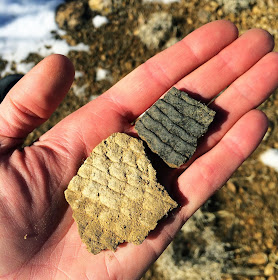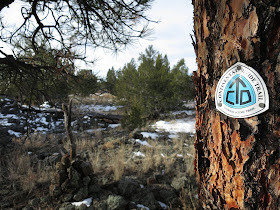A snowy dayhike at Natural Bridges National Monument in southeastern Utah.
 |
| Natural Bridges National Monument, Utah. |
Nine inches of snowpack lingers on north facing slopes. I creep down the snow-ice covered slickrock. The descent takes me longer than a regular 500 foot decent should, with all the butt-scooting and taking the microspikes on and off for every wooden ladder.
 |
| Ladders. |
A layer of snow covers the most recent human tracks so there hasn’t been anyone down here for a few days. At the base of the canyon, the quiet is broken by the sweet sound of running water under ice.
The air pools cold and heavy in canyon bottom. The homey smell of cottonwood greets me. How can cottonwood smell? Ah but it does and brings back flashes of memories of countless nights in my hammock under rustling leaves.
 |
| Cottonwood. |
Why does no one bottle up this fragrant perfection into shampoos or perfume? Lilac or vanilla is so boring compared to Damp Cottonwood in January.
 |
| Sipapu Bridge is the second largest natural bridge in the world. |
I turn up Deer Canyon. With no other footprints to follow this way, I sink deeply into snow. My backpacking pack is heavy with all the supplies I’d need just in case something happens and I have to spend the night out. Extra precautions for solo winter hikes.
 |
| No tracks here. |
There is something enchanting about the fresh snow, the uncracked ice spanning the creek. So peaceful. Leaving footprints in this smooth snow seems like spoiling this canyon, so I try jumping rock to rock.
 |
| Peaceful. |
There is a small rock scramble or slickrock traverse to get up. If I were with one other person, there would be no hesitation. I’ve done more difficult climbs with ease. But something in my brain snaps about being out here alone in the cold winter, and a wave of fear clouds my thinking. I hesitate halfway up, then crabwalk back down.
 |
| Not making it any further than this. |
Half an hour is spent walking the base and thinking about potential injury and how it’s suppose to snow tonight and worse case scenerios. I am my own most cautious hiking partner, maybe my own worst hiking partner, or maybe I am just making smart choices, it’s hard to tell the difference sometimes. I try to be OK with just being out here at all, and not get too worked up about not taking risks. I continue on the designated trail, reluctantly leaving side trips for another day.
 |
| Marveling at the rock pile under Kachina Bridge caused by the 1992 rock fall. Geology in action! |
 |
| One site the rangers can tell you about. Show your respect by staying outside of the fenced area and not
damaging anything. |
Because the rangers recommended not trying to get to the Owachomo Bridge
due to ice, that part of the trail had to wait until next time.
 |
| A few more footprints make for an easier ascent from the canyon. |
 |
| Kachina Bridge from above. |
On the roadwalk back to the parking area, a short trail led to an overlook for Horsecollar Ruins, far below in an alcove near the bottom of the canyon. Always fascinating to get a different perspective by hiking on the rim above the canyon you’ve been exploring.
Overall, Natural Bridges National Monument is a fascinating place for having three natural bridges so close together. The snow-covered sandstone and ice formations along the flowing creek were stunning. The paved roads and parking areas were all plowed, making it relatively accessible for this time of year.
For more information:
Be sure to stop at the excellent visitors center. Before I set out, knowledgable rangers described the significance of the area and gave suggestions for routes through the snow. They also provided hiking maps and informative handouts.
Natural Bridges National Monument

























































